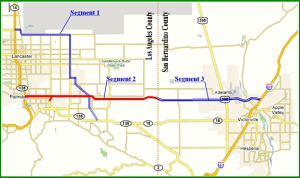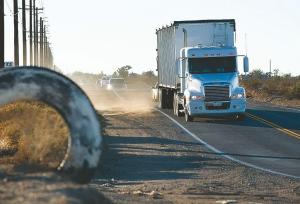The California Department of Transportation is planning to build a 63-mile highway that will link the Antelope Valley and the Victor Valley.
The High Desert Corridor Project, a collective project of Los Angeles County Metropolitan and Caltrans, is designed to connect the fastest growing residential areas such as Lancaster, Adelanto and Victorville to serve passengers who travel across Mojave desert.
The project that will include solar installations, charging stations for electric cars and bike lane, is designed to connect two proposed high-speed rail system, the road and several cities across the Mohave Desert.
But with the cost of $8 billion, is the ambitious transportation project feasible?
Last months, county officials released a report about the project.
According to the plan, the highway will run through the City of Palmdale and will connect Fresno, Burbank and San Bernardino County.
Palmdale will play a role of a transportation hub, with a station that will link the Palmdale Transpiration Center and Metrolink trains, the report stated.
The High Desert Corridor will connect the highway with the terminal at the Palmdale Regional Airport, which Metro officials are planning to open again after it was closed for six years.
On their website, Metro officials said highway will cost from $4 billion to $8 billion. The construction of the four-lane freeway will start in four years and will be completed by 2024.
As the population of the Antelope Valley will grow 50 percent by 2020, the highway might be seen as a chance to push for the commercial and economic growth. Antelope Valley officials, a city known for its gravitation towards innovations, were pushing for the project.
The highway will stretch through 3,200 acres of land, an area that doesn’t include the railway that will occupy additional area.
The highway will run through 252 acres of farmland and 2,9000 acres of grazing land, that might become a disturbance with natural inhabitants such as Golden Eagle and desert tortoise.
But the major problem for the agency in charge is still ahead: Metro is the leading agency of the proposal are required to submit a route and get the funding.
By spring Metro will announce its decision on the route of the freeway.
The biggest concern is the financing, which is very unclear at this point.
The Metro High Desert Corridor posted on their website that the estimated cost will be included in the Environmental Impact report is which is currently underway.
Officials are planning to allocate $30 million from Measure R, a half-cent sales tax passed in 2009 that contributes to financing the county’s transportation projects.
But some critics say the project will more likely heavily depend on the private financing.
Environmental activists might also oppose the project.
Transportation official noted in the report that solar panels will be installed along the freeway, and creators hope they will produce energy for charging stations, according to the Metro’s website.
With the solar panels producing energy for streetlights and electric cars charging stations, Metro officials say they hope the highway will be self-sustaining and bring new economic opportunities to the region.



Leave a Reply
You must be logged in to post a comment.